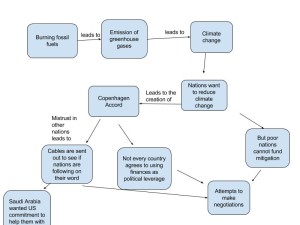In this diagram I wanted to display the connection between climate change and mitigation. As discussed in this module, climate change is caused by the burning of fossil fuels. By burning these fossil fuels, greenhouse gases are emitted into the atmosphere and this leads to the troposphere increasing in temperature. This then leads to climate changes around the world and is a problem for many nations. They understand that collective action needs to be done in order for effective changes to take effect. Although countries meet to discuss how each of them can take action in reducing climate change, there are always some difficulties in determining a method that will work for every country in the agreement. As shown in the diagram, the Copenhagen Accord was created in the hopes of reducing climate change, but in this, there were levels of distrust in other nations. This led to cables being sent out to determine the trustworthiness of other nations. In addition to this, although many nations want to participate in this mitigation, less wealthy nations have a more difficult time in agreeing to certain treaties. While these treaties request that nations reduce actions that lead to greenhouse gas emissions, poorer nations cannot afford to do so. These countries still need to industrialize and, therefore, not as likely to agree with these obligations. A third reason that these treaties have not worked so far is that some countries do not agree with the use of finances as political leverage. If they do not agree with using their money in the same way, they will not agree to the accord. With the need for mitigation to reduce climate change, there have been many attempts to negotiate adequate treaties.
After reading this module, it concerns me that decisions relating to climate change will never be solved. I’m concerned that it will all be talk and there will not be much action, and as this happens there will be even more climate change for the worse. I think that issues like this are extremely important to solve, as they influence everyone on the planet and if they are not solved, there will be consequences. I think that there is a collective action problem in this situation since these many nations are not working collaboratively towards effective action. As collective action refers to actions done by a group on a collective decision, the nations of the world need to negotiate to make an agreement. Although this decision is a hard one to negotiate, it is understandable. As stated earlier, less wealthy nations still need to use machinery to maintain their country’s economy and lifestyle so they still need to emit the same amount of greenhouse gases and cannot afford to reduce them. In this case it is hard for them to settle on an agreement. In addition to this, more wealthy nations typically are accustomed to using cars and similar methods of transportation for travel and it would be difficult to change the accustomed actions of the citizens of these countries. What I do not necessarily comprehend is why the cables have been made public. I assume that they were publicized in order to receive feedback from the public, in the case that the public would loudly voice their opinions, but through this, I feel like this would more so create more varying opinions and mitigations would be less likely to happen. I think that there are many ways that climate mitigation can occur, but I am concerned on when it will happen and the extent of which it will happen.


Hey Laura! My name is Cassandra Oresko and I caught interest in your blog mainly because we had similar and different ideas in regards to our diagram. We both mainly focused on climate changes issues in our diagram. You and I clearly stated the issue of this ongoing situation and how burning fossil fuels leads to the emission of greenhouse gases. However, you took it an extra step farther and explained in great detail Copenhagen Accord. Not only did you explain why this treaty became an issue of distrust, but you explained in detail what cables did to make sure other nations are following their word, such as Saudi Arabia. Overall, you created an incredible diagram and it was amusing and easy to read!
If you get the chance, please check out my blog post!
http://geog030.dutton.psu.edu/2016/04/05/cassandra-oresko-climate-change-module-9/
Hey Laura, I really liked your graphic. My blocks went in linear order, but in the real situation there are influences from all over the place, so yours did a much better job of capturing that. I also liked how you argued for why the cables shouldn’t have been leaked. After reading your post, my views changed slightly from where they were originally. I previously believed that the manor in which the cables were obtained was ethical, but I thought that it was a good idea to let the public know what was going on behind closed doors. Now I see how risky it really was. Feel free to check out my post to see if we had any other similarities or differences in our thinking.
Hi Laura, my name is Alyssa. I enjoyed reading your post and diagram because you had a lot of interesting thoughts. For example, I liked how you talked about why you think the cables shouldn’t have been made public. I wrote about how I like that they were because it creates more honesty and moves away from all of the distrust. I do agree with your argument, however, that it may create more opinions, slowing down the process of mitigation. If you want to check out my post, here’s the link: https://sites.psu.edu/geog30/?p=52362&preview=true